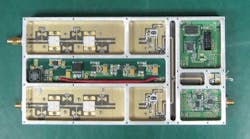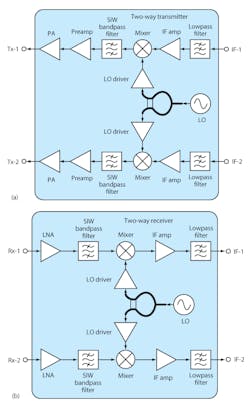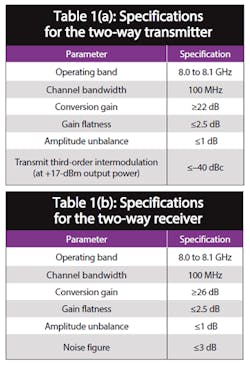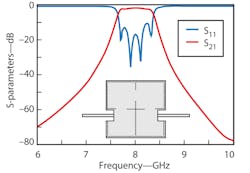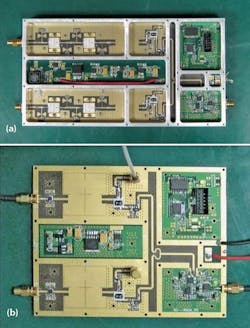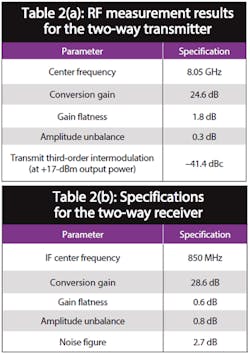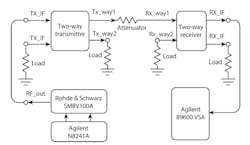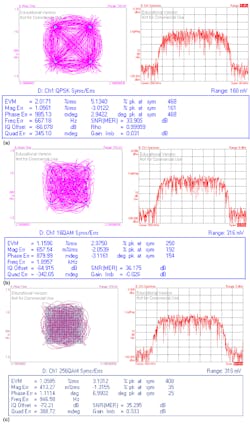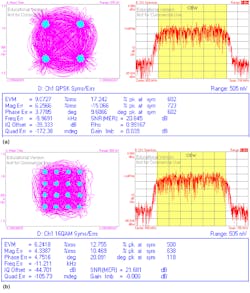This file type includes high resolution graphics and schematics when applicable.
Fast data transfers usually require large bandwidths. But the use of multiple-input, multiple-output (MIMO) antenna techniques can also boost data rates for available bandwidths, as shown with this high-performance two-way transmitter and receiver design operating with a 100-MHz bandwidth at 8.05 GHz. It boasts excellent performance, with a receiver noise figure of 2.7 dB and transmitter output power of +17 dBm at 8.05 GHz and associated third-order intermodulation (IM3) level of −41.4 dBc. In addition, the MIMO-based system achieves measured error-vector-magnitude (EVM) performance of 9.07% for an 83.3-MSymbol/s quadrature-phase-shift-keying (QPSK) signal and 6.24% for an 83.3-MSymbol/s 16-state quadrature-amplitude-modulated (16QAM) signal.
Expectations are high for fast data access in both fixed and mobile wireless applications. According to the International Telecommunications Union (ITU), fourth-generation (4G) wireless communications networks should support data rates to 1 Gb/s for low-mobility applications and 100 Mb/s for high-mobility applications.1 To meet these requirements, advanced technologies are needed, including high-level modulation schemes, orthogonal frequency division multiplexing (OFDM), and MIMO techniques, and the channel bandwidth should be at least 100 MHz.2-5 However, most existing communications standards employ no more than 20 MHz bandwidth.6 The most desirable RF/microwave bandwidths, below 6 GHz, are already well occupied, so that next-generation wireless applications are expected to operate in the next higher-frequency available bands from 6 to 15 GHz,7 where continuous multiple 100-MHz channel bandwidths are available.
To explore the possibilities for high-data-rate wireless communications in that 6-to-15-GHz band, a two-way transmitter and receiver for use with MIMO wireless techniques at 8.05 GHz were designed and implemented.
Figures 1(a) and (b) show block diagrams of the two-way MIMO transmitter and receiver, respectively. The subsystems employ a classic superheterodyne transceiver architecture. The center frequency of the transmitting and receiving IF signal is set at 850 MHz, with a bandwidth of 100 MHz. The required RF specifications for the transmitter and receiver are listed in Tables 1(a) and (b), respectively.
For the two-way transmitter and receiver, the local oscillator (LO) is comprised of a phase-lock-loop (PLL) frequency synthesizer. To meet the high linearity requirement listed in Table 1(a), a passive mixer, which requires +17 dBm LO drive power, is used for the receiver, and an LO drive amplifier is used with each mixer. To meet the conversion gain requirement of the two-way transmitter, an intermediate-frequency (IF) amplifier and two RF power amplifiers cascaded together are also used.
For the two-way receiver, a low-noise amplifier (LNA) with adequate gain helps meet the noise-figure requirements for the downconversion signal chain listed in Table 1(b). Following downconversion, a low-noise IF amplifier is added to provide suitable conversion gain, and to minimize the impact of the following stage on the noise figure of the receiver.
System-level simulations were carried out for the RF transmitter and receiver using Advanced Design System (ADS) software from Agilent Technologies (www.agilent.com). All the RF bandpass filters in the two-way transmitter and receiver were based on substrate-integrated-waveguide (SIW) techniques,8-10 for suppressing image signals, LO signals, and other interference. The SIW filters are low in cost and compatible with standard printed-circuit-board (PCB) fabrication methods. The SIW filters are designed and simulated with the help of the full-wave High-Frequency Structure Simulator (HFSS) electromagnetic (EM) simulation software from Ansoft Corp. (www.ansys.com). Simulation results are shown in Fig. 2.
Following the simulations, the two-way RF transmitter and receiver designs were fabricated and integrated on PCBs. A frequency-control module was also included, to control the PLL frequency. Figure 3 shows photographs of the fabricated prototypes.
The measured performance of the two-way transmitter and receiver (RF = 8.0 to 8.1 GHz, LO = 7.2 GHz, IF = 800 to 900 MHz) includes the output power of the transmitter (when the IF input power = −5 dBm), the conversion gain of the receiver, and the IM3 product of the transmitter (when the output power = +17 dBm). Detailed measured results are listed in the Tables 2(a) and (b).
To measure the overall performance of the transmitter and receiver as a communications system, a test system consisting of the prototype transmitter and receiver was constructed to measure the EVM performance. Figure 4 shows a schematic diagram for the EVM measurement setup. The frequency-conversion plan was: RF = 8.0 to 8.1 GHz, LO = 7.2 GHz, IF = 800 to 900 MHz. In the test setup, a model SMBV100A vector signal generator from Rohde & Schwarz (www.rohde-schwarz.com) was modulated with in-phase/quadrature (I/Q) signal generated by an N8241A arbitrary waveform generator (AWG) from Agilent Technologies.
The modulated IF signal is first upconverted by the transmitter, then sent through an appropriate attenuator (to simulate path loss), and then downconverted by the receiver. The resultant IF signal is demodulated and analyzed by a model 89600 vector signal analyzer (VSA) from Agilent Technologies to determine the EVM. During the measurement process, several baseband signals with different modulation types and symbol rates were applied.
Figure 5 shows measured EVM results for a 20-MSymbol/s baseband signal applied with modulation of (a) QPSK, (b) 16QAM, and (c) 256-state quadrature amplitude modulation (256QAM). Under those three modulation conditions, the measured EVM values were 2.02%, 1.16%, and 1.06%, respectively. To test the wideband performance of the transmitter and receiver, an 83.3-MSymbol/s (with occupied bandwidth of 92.5 MHz) baseband signal was applied with the following modulation formats: (a) QPSK and (b) 16QAM, with resulting EVM of 9.07% and 6.24%, respectively. The measured EVM results are shown in Fig. 6. The measured results show that the two-way MIMO communication system can support high spectrum efficiency and high data rate communications with low EVM.
6. The experimental system EVM was measured with 83.3 MSymbols/s and baseband signals with: (a) QPSK and (b) 16QAM.
In summary, low-cost, high-performance two-way transmitter and receiver designs were developed for use at 8.05 GHz. They support high data rates over a 100-MHz bandwidth using MIMO techniques. Measurements reveal low EVM for reliable high-data-rate performance with high spectral efficiency.
Acknowledgments
This work was supported in part by the NSFC under Grant No. 60921063, and in part by the National Science and Technology Major Project of China under grants No. 2010ZX030007-02-01 and 2011ZX03004-003.
References
1. Z. Yu, J. Zhou, J. Zhao, and W. Hong, “Design of a Wideband RF Receiver for the Next-Generation Wireless Communication System,” 2009 Asia-Pacific Microwave Conference, Singapore, December 2009, pp. 465-468.
2. A.J. Paulraj, D.A. Gore, R.U. Nabar, and H. Boelcskei, “An Overview of MIMO Communications—A Key to Gigabit Wireless,” Proceedings of the IEEE, Vol. 92, No. 2, 2004, pp. 198-218.
3. T. Kaiser, A. Wilzeck, M. Berentsen, and M. Rupp, “Prototyping for MIMO systems: an Overview,” in Proceedings of the 12th European Signal Processing Conference (EUSIPCO ‘04), Vienna, Austria, September 2004.
4. J. Thanysen and K. B. Jakobsen, “Checking capacity for MIMO configurations,” Microwaves & RF, Vol. 46, No. 6, 2007, pp. 74-82.
5. J. Browne, “Measuring MIMO Performance Levels,” Microwaves & RF, Vol. 49, No. 7, 2010, p. 102.
6. M. Sauter, Beyond 3G – Bring Networks, Terminals and the Web Together: LTE, WiMAX, IMS, 4G Devices and the Mobile Web 2.0, Wiley, New York, 2009.
7. J. Walko, “Mobile Operators Under Pressure in Barcelona-3GSM report,” Picochip EETimes Europe, February 1-March 4, 2007.
8. D. Deslande, and K. Wu, “Integrated microstrip and rectangular waveguide in planar form,” IEEE Microwave Component Letters, Vol. 11, No. 2, 2001, pp. 68-70.
9. Z.C. Hao, W. Hong, J.X. Chen, X.P. Chen, and K. Wu, “Compact Super-Wide Bandpass Substrate Integrated Waveguide (SiW) Filters,” IEEE Transactions on Microwave Theory and Techniques, Vol. 53, No. 9, 2005, pp. 2968-2977.
10. H.J. Tang, W. Hong, et al., “Development of millimeter-wave planar diplexers based on complementary characters of dual-mode substrate integrated waveguide filters with circular and elliptic cavities,” IEEE Transactions on Microwave Theory and Techniques, Vol. 55, No. 4, 2007, pp. 776-782.
This file type includes high resolution graphics and schematics when applicable.
